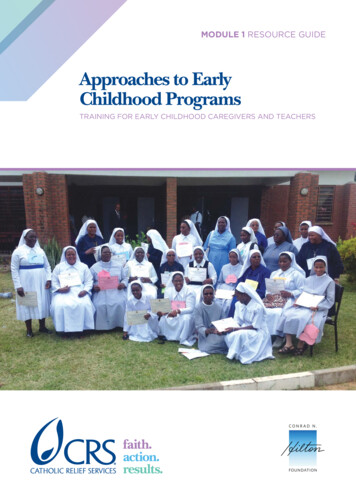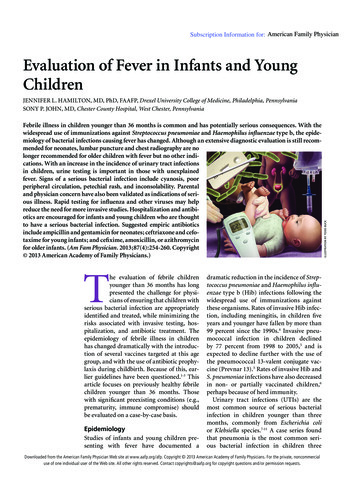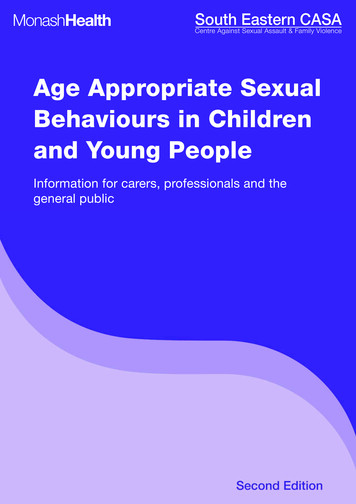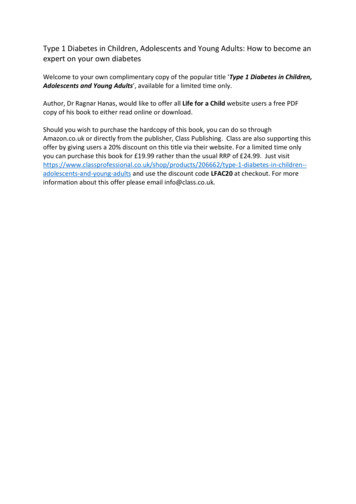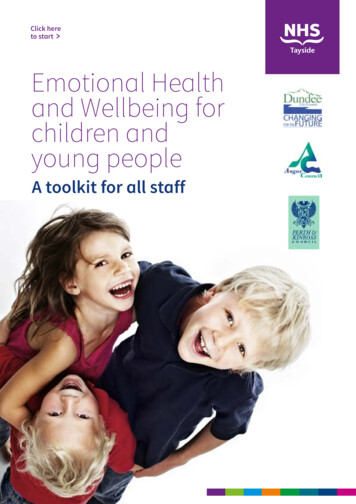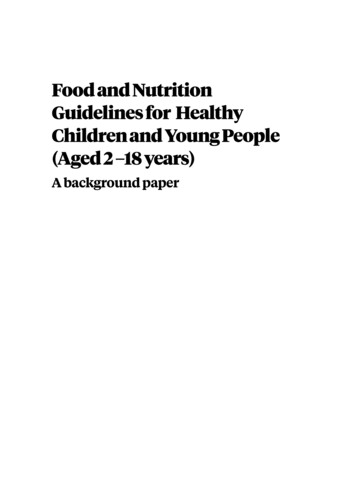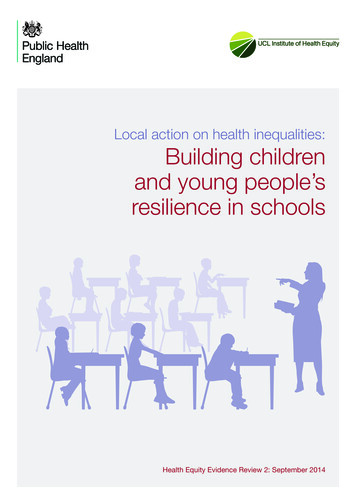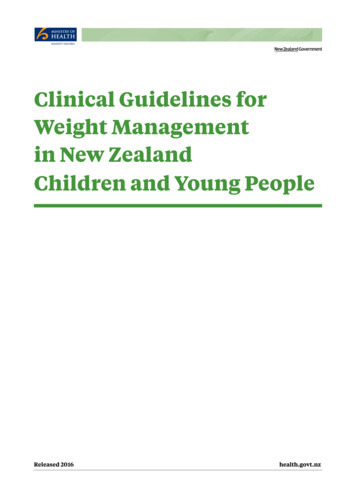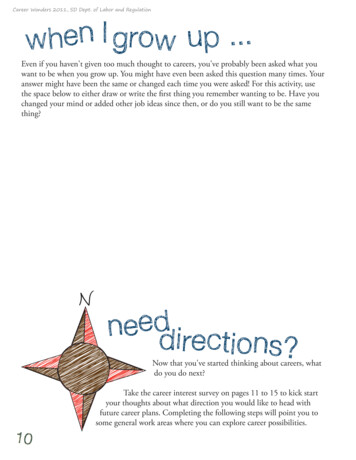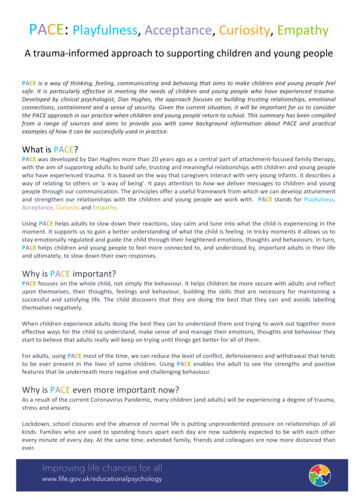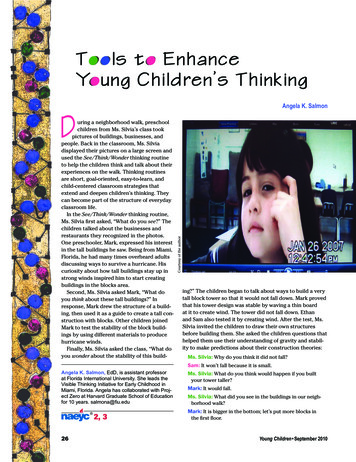
Transcription
Tools to EnhanceYoung Children’s ThinkingAngela K. SalmonAngela K. Salmon, EdD, is assistant professorat Florida International University. She leads theVisible Thinking Initiative for Early Childhood inMiami, Florida. Angela has collaborated with Project Zero at Harvard Graduate School of Educationfor 10 years. salmona@fiu.edu 262, 3Courtesy of the authorDuring a neighborhood walk, preschoolchildren from Ms. Silvia’s class tookpictures of buildings, businesses, andpeople. Back in the classroom, Ms. Silviadisplayed their pictures on a large screen andused the See/Think/Wonder thinking routineto help the children think and talk about theirexperiences on the walk. Thinking routinesare short, goal-oriented, easy-to-learn, andchild-centered classroom strategies thatextend and deepen children’s thinking. Theycan become part of the structure of everydayclassroom life.In the See/Think/Wonder thinking routine,Ms. Silvia first asked, “What do you see?” Thechildren talked about the businesses andrestaurants they recognized in the photos.One preschooler, Mark, expressed his interestin the tall buildings he saw. Being from Miami,Florida, he had many times overheard adultsdiscussing ways to survive a hurricane. Hiscuriosity about how tall buildings stay up instrong winds inspired him to start creatingbuildings in the blocks area.Second, Ms. Silvia asked Mark, “What doyou think about these tall buildings?” Inresponse, Mark drew the structure of a building, then used it as a guide to create a tall construction with blocks. Other children joinedMark to test the stability of the block buildings by using different materials to producehurricane winds.Finally, Ms. Silvia asked the class, “What doyou wonder about the stability of this build-ing?” The children began to talk about ways to build a verytall block tower so that it would not fall down. Mark provedthat his tower design was stable by waving a thin boardat it to create wind. The tower did not fall down. Ethanand Sam also tested it by creating wind. After the test, Ms.Silvia invited the children to draw their own structuresbefore building them. She asked the children questions thathelped them use their understanding of gravity and stability to make predictions about their construction theories:Ms. Silvia: Why do you think it did not fall?Sam: It won’t fall because it is small.Ms. Silvia: What do you think would happen if you builtyour tower taller?Mark: It would fall.Ms. Silvia: What did you see in the buildings in our neighborhood walk?Mark: It is bigger in the bottom; let’s put more blocks inthe first floor.Young Children September 2010
Courtesy of Silvia de ArmasMs. Silvia continued to use the See/Think/Wonderthinking routine to discuss the children’s drawings oftall buildings in ways that would make their thinkingvisible. The Visible Thinking approach to teachingand learning uses thinking routines and documentation created by children or teachers to make thethinking process more visible in the classroom in anatural, manageable way. Through this thinking routine, the children connected their concepts of stability, foundation, and gravity to what they saw on thefield trip and also to their drawings and block buildings. They continued to wind-test their structures,and they changed their drawings and buildings asthey analyzed and discussed their findings for morethan a month.Effective teachers are powerful mediators of children’s thinking and learning. They design learningenvironments that stimulate children’s curiosity. Asthis example illustrates, teachers can also engagechildren in thinking routines throughout the curriculum to provoke thinking and promote metacognitive(thinking about thinking) activities.and InnovativeToolsforLearningCourtesy of Ana SeoaneTraditionalTeachers who promote young children’sEffective teachersthinking by using thinkare powerful mediaing routines commonlyThinking routinessee children using ators of children’sThinking routines typically consist of a series of queslanguage of thinkingthinking and learntions that teachers ask children in order to lead themduring play activitiesthrough the steps of critical thinking and to help themin the dramatic play,ing. They designunderstand where their own ideas come from. These roublock, or writing areas.learning environtines support children’s development as self-directed learnWhen the childreners and promote learning for understanding (Project Zeroin the opening storyments that stimulate2010). They help children make connections between familabout the block activitychildren’s curiosity.iar and relevant events in their lives.tried to explain theirtheories aboutstability, gravity, and other physics concepts by discussing theirideas, drawing plans, and building block buildings,they were externalizing their thinking. Ms. SilviaWind Teststimulated Mark’s thought process when she usedthe See/Think/Wonder routine while he observed,Testing stability!drew, and constructed his building.Ritchhart and colleagues state that childrenThe children werecan activate a routine just by naming it and thatonly through repeated practice will it become aintroduced to the windroutine (Ritchhart et al. 2006). In this example, astest.the teacher uses the routine over time, her questions trigger the children to open their minds toMark began his testobserve, think, and inquire (See/Think/Wonder).Thinking routines are a primary strategy for orgato see if the towernizing memory; they are crafted to achieve specificwould fall . . . ?goals, such as making connections or deep inquiry(Project Zero 2010). Young children can expandtheir repertoire of thinking strategies when they areexposed to and use thinking routines.Young Children September 201027
When thinking is part of their routine,children become alert to situationsthat call for thinking.Ilene: But it can hold it like this (manipulating the cloth androck). [She is reasoning with evidence.] Ellen B. SenisiMs. Karla: Alexander, you are puzzled or wondering about theweight and size, right? Ilene, is that how you want to explorehow to hold a big and heavy rock with this piece of cloth?Alexander: This is my dad (pointing to the rock). It is big andstrong, see? (Alexander puts the rock on a branch, trying toprevent it from falling.)The Project Zero Visible Thinking project (Project ZeroIlene: No, it’s better with this, it is bigger (inviting Alexander2010; Ritchhart & Perkins 2008) developed a set of short,to use the piece of cloth again).easy-to-learn thinking routines that target different types ofMs. Karla’s questions prompted the children’s thinkingthinking (see “Thinking Routines”). Teachers can use theseand problem solving.thinking routines during circle time and small- and largeAs this example illustrates, thinking routines are flexible,group activities. Teachers might also observe children’sallowing teachers and children to modify them to meetplay and step in, without causing disruption, to use antheir needs (Ritchhart et al. 2006). When thinking is part ofappropriate thinking routine to help children take their playtheir routine, children become alert to situations that callto a higher level, thus promoting learning.for thinking. As a result, they develop positive attitudesThinking routines help children construct knowledgetoward thinking and learning (Ritchhart 2002; Ritchhart &from prior experiences and are meaningful and functionalPerkins 2008).(NAEYC 2009; Salmon 2010). Four-year-old Alexander founda rock on the playground. He was interested in makingthe rock stay perched in the branches of a tree. This wasMaking thinking visiblethe perfect opportunity for Ms. Karla to promote deeperinquiry and help him think with evidence by using theWhen educators try to engage young children in thinkingThink/Puzzle/Explore routine, combined with the Whatand talking about thinking, they are confronted with theMakes You Say That? routine. Alexander’s natural curiosityegocentric and concrete ways that young children think.to test how gravity works was an open invitation for otherOne simple problem with thinking is that it is invisible. Onechildren in the playground, including Ilene, toquestion and explore how to prevent the objectfrom falling down.Thinking RoutinesIlene offered Alexander a piece of cloth, andthey both tried to use it to build something thatencourages this type of thinkingThis routine . . .would prevent the rock from falling. In the process, the children and teacher verbalized theirinterpretation with justificationWhat Makes You Say That?thoughts and inquiries, prompted by the twothinking routines:setting the stage for deeper inquiryThink/Puzzle/ExploreMs. Karla: Why do you think this rock is falling?Alexander: This rock is my dad, he is big. [Alexander ismaking connections.] (As Alexander begins testing rocksof different sizes, the rocks continue to fall off thebranch.)Ms. Karla: Let’s Think/Puzzle/Explore how this canwork. Why is it falling?Ilene: This (cloth) can hold it. [Ilene is problem solving.]Ms. Karla: What makes you say that?Alexander: No, no, this is big . . . and heavy too. [He isreasoning with evidence.]28Think/Pair/Shareactive reasoning and explanationCircle of Viewpointsexploring diverse perspectivesI Used to Think . . .Now I Think . . .reflecting on how and why ourthinking has changedSee/Think/Wonderexploring works of art and otherinteresting thingsColor, Shapes, Linesexploring the formal qualities of artSource: Project Zero 2010.Young Children September 2010
Traditionaland InnovativeToolsforLearningof a teacher’s tasks is to find ways to make young children’sWhen the author asked a group of teachers, “What is thinkthinking visible to themselves and others (Perkins 2003).ing?” they came up with different responses, ranging fromA key component of the Visible Thinking approach makesstrategies they use to understand something to ways ofthinking visible by documenting learners’ unfolding ideasmanaging information. When teachers think about thinkas they think through issues, problems, or topics. Teachersing, their teaching style tends to be more child-centeredcan document children’s thinking by using different media,(Barahal 2008).such as video techniques and transcribed conversationsUsing the language of thinking in daily routines and converaccompanied by photographs and children’s work. Asations with children fosters a classroom culture of thinking.thoughtful display of documentationin the form of “thinking maps” canhelp children and teachers connectideas and observations. For example,teachers can create a visual presentation that includes a child’s drawingsabout an idea and her transcribedwords organized in a way that showsher thinking process.According to Roskos and Christie(2002), play activity is shaped by thehere-and-now, the just-previous activity, and all sorts of ideas and notionschildren have accrued from past experience. By using thinking routines anddocumenting the children’s responses,teachers can make children aware oftheir own thinking. Teachers can thenscaffold children’s language and concepts about the world (Salmon 2010).By bringing to light what childrenunderstand, teachers can help themreach a higher level of development(Vygotsky [1930–35]1978).Documentation also enables youngchildren to see their own thought processes. When children speak, write,Music Together goes beyond the once-a-week music model,draw, build, or dramatize their ideas,makingmusic an essential and engaging part of your core curriculumthey are making their thinking visible.forteachers,parents, and students. Call us to discover how you can bringTeachers, children, and parents benthe power of music to your early childhood learning community.efit from examining documentationthat reveals the ideas and modes ofthought children bring to school. Byenhancing children’s thinking, thinking routines also promote a culture ofthinking in young children (Ritchhart2002; Salmon 2008).PRLHAPPy cHiLDRen .conneCteD PARents.musiCAl coMMunity.OOLRE SOE S C HOCHPBuilding a culture of thinkingA culture is shaped by the beliefsand practices shared by the membersof a community. To create a classroom culture of thinking, teachers canbegin by revisiting their own beliefsabout and understanding of thinking.Young Children September 2010(800) 728-2692 X353 MusiCtogetHeR.CoM/nAeycad size: 4.265”wide by 7.375” high29
Thinking can include many different mental processes, suchas compare, infer, explain, and analyze. Consider the difference between “Let’s look at these two pictures” and “Let’scompare these two pictures.” The verb compare encourages children to use a higher level of critical thinking.Thinking routines help incorporate thinking languageinto the classroom because they both promote a thinkingdisposition in children and create the language to do so.Thinking dispositions are inclinations and habits of mindthat support productive thinking and are teachable overtime across diverse situations (Tishman, Perkins, & Jay1995; Ritchhart 2002; Ritchhart & Perkins 2008).provoking good thinking. If a teacher asks a child what he isthinking about, a child may respond, “I’m thinking about mydog,” or “I’m thinking about my birthday party.” Childrentypically respond to this question by mentioning objects,people, or events in their lives. If a teacher asks a questionthat already contains the answer—for example, “Do youthink with your brain?”—the child will probably give theshort and obvious answer, yes.On the other hand, if the teacher asks a child an openended question—such as “What is good thinking?”—shecan expect a variety of responses, depending on the natureof the question. For example, 5-year-old David’s response tothis question was, “It’s a hard question (he closed his eyesand continued) . . . because it is invisible.” This responseshowed the teacher that David was thinking beyond memories of concrete things (mom, toy) or of events to graspconcepts that are essentially “invisible.” These kinds ofquestions help children see that thinking goes beyondrecognizing objects and memories to being a method forsolving problems or understanding the world. Researchindicates that teaching children to be alert to or describewhat’s going on inside their heads helps them to becomeaware of their own language and thoughts (Costa 1987)—anessential step in learning to learn.Children’s conceptions of thinkingThinking about thinking is a difficult task for a youngchild, but not impossible for a teacher to encourage. Theway a teacher asks questions can make a difference inCourtesy of Adriana AlvaradoThinking through art30The arts can foster critical thinking and the ability touse logic and reasoning in problem solving. For example,the 3-year-olds in Ms. Alvarado’s class used a routine theirteacher created, See/Think/Explore, to analyze the art ofCarlos Cruz-Diez. This artist uses color changes to createa sensation of movement as the viewer shifts position.While investigating these color and line effects, the childrendeveloped critical thinking and problem-solving skills.In a follow-up activity, Ms. Alvarado hung from the ceilingcolored pieces of yarn and objects of different shapes toinspire the children to use the Colors/Shapes/Lines thinking routine to explore the formal qualities of art. One of thechildren, who had limited knowledge of English, identifiedall of the shapes that he could create by manipulating theyarn and by moving from one place to another. In the process, he connected the colors and shapes from the yarnwith real objects around the classroom and with his orangebicycle at home. In his explorations, he began to use theEnglish vocabulary that the children had used when analyzing the Cruz-Diez painting in the See/Think/Explore activity. Throughout his yarn explorations, he verbalized histhoughts and created stories connected to the yarn designshe made. In this case, the teacher’s use of the See/Think/Explore routine fostered the child’s deeper inquiry and recreation of designs that had meaning to him.Young Children September 2010
TraditionalThinking routines and documentationare tools that enhance children’s cognitive development by helping thembecome aware of their own creativethinking and problem-solving skills.Conclusionand InnovativeToolsforLearningProject Zero. 2010. Research projects: Visible thinking. Cambridge,MA: Harvard Graduate School of Education. chhart, R. 2002. Intellectual character: What it is, why it matters, andhow to get it. San Francisco: Jossey-Bass.Ritchhart, R., P. Palmer, M. Church, & S. Tishman. 2006. Thinkingroutines: Establishing patterns of thinking in the classroom. Paperpresented at the American Educational Research Association AnnualMeeting, 7–11 April, San Francisco, California.Ritchhart, R., & D. Perkins. 2005. Learning to think: The challenges ofteaching thinking. In Cambridge handbook of thinking and reasoning,eds. K.J. Holyoak & R.G. Morrison, 775–802. New York: CambridgeUniversity Press.Ritchhart, R., & D. Perkins. 2008. Making thinking visible. EducationalLeadership 65 (5): 57–61.Roskos, K.A., & J.R. Christie. 2002. “Knowing in the doing”: Observingliteracy learning in play. Young Children 57 (2): 46–54.Salmon, A. 2008. Promoting a culture of thinking in the young child.Early Childhood Education Journal 35 (5): 457–61.Salmon, A. 2010. Engaging children in thinking routines. ChildhoodEducation 86 (3): 132–37.Tishman, S., D. Perkins, & E. Jay. 1995. The thinking classroom: Learningand teaching in a culture of thinking. Boston: Allyn & Bacon.Vygotsky, L.S. [1930–35] 1978. Mind in society: The development of higherpsychological processes. Ed. and trans. M. Cole, V. John-Steiner, S.Scribner, & E. Souberman. Cambridge, MA: Harvard University Press.PICTURE BOOKSPERFECT FOR PRESCHOOLSDOG LOVES BOOK49-0978-0-375-864 49-0645-8GLB: 978-0-37ReferencesYoung Children September 2010THE EENSY WEENSY SPIDERFREAKS OUT! (BIG TIME!)978-0-375-86582-4GLB: 978-0-375-96582-1Illustration 2010 by Elise Primavera.Barahal, S. 2008. Thinking about thinking: Preservice teachers strengthen their thinkingartfully. Phi Delta Kappan 90 (4): 298–302.Costa, A. 1987. Teaching the language of thinking. Educational Leadership 45 (2): 29–33.NAEYC. 2009. Position Statement. Developmentally appropriate practice in early childhoodprograms serving children birth through age 8.Washington, DC: Author. Perkins, D. 2003. Making thinking visible. NewHorizons for Learning. pics/thinkingskills/visible.Illustration 2010 by Louise Yates.Critical thinking is an active, purposeful, and organizedcognitive process. Research has shown it can be explicitlytaught (Tishman, Perkins, & Jay 1995; Ritchhart & Perkins2005, 2008; Barahal 2008; Salmon 2010). Teachers’ use ofroutines is important, not only to give children a senseof security and confidence, but also to create habits ofmind as they develop a culture of thinking. When thinkingroutines become part of the classroom culture throughSLM PreschoolBks NAEYC.qxp:Layout1 7/2/10 10:19 AM Page 1repeated practice, they create patterns of thinkingandlearning that become part of the child’s intellectual characCopyright 2010 by the National Association for the Education of Young Children.See Permissions and Reprints online at www.naeyc.org/yc/permissions.ter (Ritchhart 2002). Thinking routines and documentationare tools that enhance children’s cognitive development by helping thembecome aware of their own creativethinking and problem-solving skills.Thinking routines are easy to teachand developmentally age-appropriate;they not only activate children’s priorknowledge but also expand their thinking. Their flexibility allows teachers toadapt thinking routines for use withyoung children. Although it can bechallenging to engage young childrenin thinking about thinking, the thinking routines provide teachers withinsights they can use in assessmentand for curriculum planning.HOW ROCKETLEARNED TO READ978-0-375-85899-4GLB: 978-0-375-95899-1THUMB LOVE978-0-375-848GLB: 978-0-375-9 81-25182-4Looking for book recommendationsand activity ideas? Sign up for thePRESCHOOL BOOK NOOK newsletter atwww.randomhouse.com/teachers31
thinking routine to discuss the children's drawings of tall buildings in ways that would make their thinking visible. The Visible Thinking approach to teaching and learning uses thinking routines and documenta-tion created by children or teachers to make the thinking process more visible in the classroom in a natural, manageable way.
